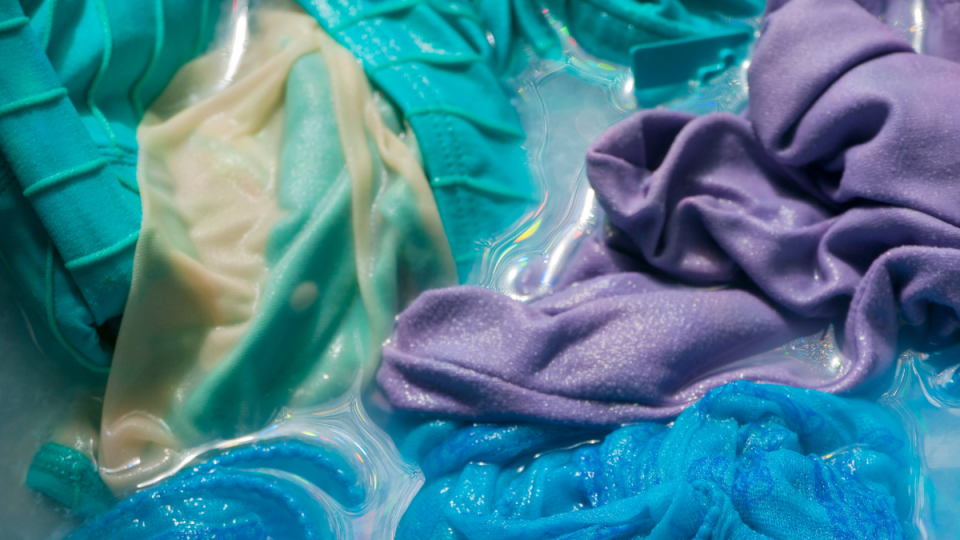How to Wash a Bathing Suit So It Lasts Longer and Fits Better
For many of us, summer signals the time to break out the bathing suits. But, whether we’re romping around outside, going for a swim or just lounging and soaking up the sun, our swimsuits are subject to a variety of factors that end up testing their durability. For example, the oils and other chemicals in many sunscreens can stain a suit and be easily absorbed by the synthetic fabrics that comprise them. Or, after some time and frequent wear, sun exposure, saltwater and chlorine can also be harsh on swimsuits and lead to color fading. Plus, if you don't wash them correctly, the material can disintegrate, stretch or shrink — and you've likely paid a pretty penny for each one! That's why it's important to know how to wash a bathing suit and take proper care of them to ensure they last. Keep scrolling for the genius tips from experts.
How to wash a bathing suit by hand
Swimsuits are typically made of nylon or polyester blended with elastane (Lycra or Spandex) which provides their stretchiness. These blends are susceptible to agitation by harsh cleaning and chemical ingredients, so they should always be washed efficiently and delicately, explains Kathleen Razmus, Director of Operations, Training and Development for garment care chain ZIPS Cleaners. The importance of following the care label for an individual piece of swimwear cannot be overstated. (Click through to help decode any laundry symbols you may find on the tag.). But, that being said there are some simple techniques you can add to make sure they're cared for best.
Related: How to Wash Jeans So They Last Longer, According to Denim + Laundry Experts
1. Rinse before washing
Razmus suggests rinsing the suit as soon as possible after use to remove any salt, chlorine, sunscreen or perspiration before it has time to sit in the fabric and potentially cause damage to the fibers.
2. Hand wash
“Wash by hand with cool water and a mild, neutral detergent,” Razmus says. “Strong detergents contain alkalis which are safe for most fabrics but may damage the Lycra and elastane fabrics that are used in many swimsuits. Nylon and polyester fabrics are more durable and can usually be washed safely with most detergents. However, hand washing of swimsuits is always recommended due to their construction, regardless of fabric type.

3. Target stains
If something has left a stain on your bathing suit, Razmus suggests applying a bit of the detergent directly on the stain and rubbing gently without abrasive scrubbing that might cause the fibers to chafe.
4. Rinse again
According to Razmus, the last step of the cleaning process is to rinse the suit completely in cool, fresh water.
How to wash a bathing suit in the washing machine
While hand washing bathing suits is the preferred method, most of them can withstand a gentle washing machine cycle. Amanda Fagan, operations manager at Tide Cleaners, says bathing suits are best processed as laundry on a delicate cycle with cold water and placed in a mesh bag to protect them.
Watch this quick TikTok video where home expert influencer @neat.caroline puts this method to the test by rinsing the bathing suit with cool tap water before hand washing it in the sink using gentle detergent.
How to dry a bathing suit
After you’ve washed your bathing suit, it’s time to let it dry. Once again, you’ll want to be as gentle and careful as possible to avoid damaging the material or the suit's elasticity. This means you should try to avoid direct application of heat and placing the item in the dryer. Instead, hang or lay them out to air dry.
“Bathing suits should not be placed in a dryer under a normal cycle. The temperature is too hot and may damage the bathing suit,” cautions Fagan. “It’s damage to the spandex that is the real issue with tumble drying in a hot dryer versus shrinkage. Heat can make the spandex brittle and break. The broken spandex sticks out. If you ever get white fuzz on a bathing suit, that can be broken spandex. This is common on the seat-area of a swimsuit. The spandex there typically breaks due to abrasion by sitting on concrete and other rough surfaces. Then, that broken spandex can get other fibers wrapped around it (pills).”
Razmus suggests patting the suit dry using soft, absorbent towels and gently squeezing (not wringing) out the excess water. Then, she says, lay the swimsuit flat to finish drying and ensure it is not in a direct line of sunlight.
Another great hack? Use a salad spinner! Just as it uses fast and powerful rotation to spin-dry lettuce, a salad spinner can help separate some moisture from the fabric of your bathing suit! This mechanism on its own won't leave the suit completely dry, but it can certainly speed up the process.
"This is a creative idea that could be used to remove excess water from the bathing suit like the spin cycle on a washing machine," says Kim Romine, P&G Fabric Care Scientist. "Just make sure to clean the salad spinner thoroughly before and after using it for this purpose."
Watch the TikTok from @christiemoeller to see this hack in action
Click through for more tips and tricks from laundry pros!
How to Wash Linen Garments + The Simple Step to Avoiding Wrinkles
How to Wash Microfiber Towels the Right Way
How to Wash a Baseball Cap — Plus the Balloon Trick That Makes It as Good as New


